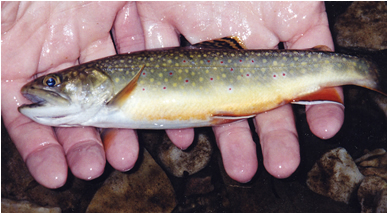March 11, 2010 — The University of Virginia and the conservation organization Trout Unlimited are looking for volunteers to collect water samples from Virginia's native trout streams during the last full week of April.
More than 150 volunteers, chemists and biologists will fan out across the state's mountainous regions as part of the Virginia Trout Stream Sensitivity Study 2010, one of the nation's largest and most comprehensive trout stream surveys. They will sample about 458 stream sites in 34 counties, representing about 80 percent of the mountain headwater streams in Virginia supporting reproducing brook trout.
Brook trout, a species of char, is the only native "trout," as it is called, in Virginia and the eastern United States. They require cool clean water and are highly susceptible to pollution, including acidity deposited through the air primarily from coal-burning power plants.
The Virginia Trout Stream Sensitivity Study is designed to track the effects of acidic deposition (often called "acid rain") and other factors that affect water quality and related ecological conditions in Virginia's native trout streams.
Water samples will be analyzed for pH, a stream's ability to neutralize acidity, and for dissolved ions. This information helps scientists determine which streams are healthy, and where problems lie.
Data and findings from the study are used for resource management and to develop, evaluate and recommend national air pollution control policies.
According to project coordinator Rick Webb, an environmental scientist at U.Va., change in the chemistry of small headwater streams provides an early indication of ecological change in the larger region.
"Following a decade of study in the 1980s, it was recognized that the central Appalachian region is the one area most likely to experience further surface water acidification, and subsequent research has shown this to be the case," Webb said. "Despite decreases in acid-forming emissions, and evidence for recovery in other regions, stream acidification continues in western Virginia."
This is the third regional survey conducted by U.Va. and Trout Unlimited. Previous surveys were conducted in 1987 and 2000. The current plan is to continue long-term monitoring by conducting surveys every 10 years. Additionally, 67 trout streams are sampled four times per year for an ongoing picture of changing conditions.
"Native brook trout and the mountain streams they inhabit are important symbols of what remains of the natural world," Webb said. "It's a measure of this importance that so many volunteers have come forward, now for the third time, to help collect the data needed to protect these fish and these streams."
To volunteer and learn more, visit the study's Web site. Webb can be reached at 540-468-2881 or rwebb@virginia.edu.
Media Contact
Article Information
March 11, 2010
/content/university-virginia-leads-trout-stream-study-seeks-volunteers

